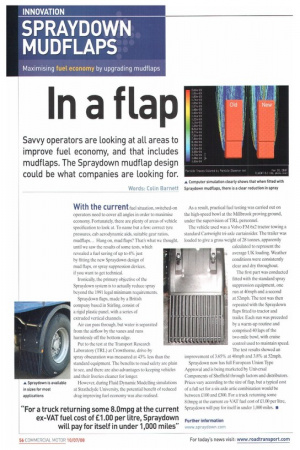In a flap
Page 56

If you've noticed an error in this article please click here to report it so we can fix it.
Savvy operators are looking at all, areas to improve fuel economy, and that includes mudf laps. The Spraydown mudf lap design could be what companies are looking for.
Words: Cotin Barnett
With the current fuel situation, switched-on operators need to cover all angles in order to maximise economy. Fortunately, there are plenty of areas of vehicle specification to look at. To name but a few: correct tyre pressures, cab aerodynamic aids, suitable gear ratios, mudflaps... Hang on, mud flaps? That's what we thought, until we saw the results of some tests, which revealed a fuel saving of up to 4% just by fitting the new Spraydown design of mud flaps, or spray suppression devices, if you want to get technical.
Ironically, the primary objective of the Spraydown system is to actually reduce spray beyond the 1991 legal minimum requirements.
Spraydown flaps, made by a British company based in Stirling, consist of a rigid plastic panel, with a series of extruded vertical channels.
Air can pass through, but water is separated from the airflow by the vanes and runs harmlessly off the bottom edge.
Put to the test at the Transport Research Laboratory (TRL) at Crowthorne, drive-by spray obscuration was measured at 43% less than the standard equipment. The benefits to road safety are plain to see, and there are also advantages to keeping vehicles and their liveries cleaner for longer.
However, during Fluid Dynamic Modelling simulations at Strathclyde University, the potential benefit of reduced drag improving fuel economy was also realised.
As a result, practical fuel testing was carried out on the high-speed bowl at the IVIillbrook proving ground, under the supervision of TRL personnel.
The vehicle used was a Volvo FM 6x2 tractor towing a standard Cartwright tri-axle curtainsider. The trailer was loaded to give a gross weight of 28 tonnes, apparently calculated to represent the average UK loading. Weather conditions were consistently clear and dry throughout The first part was conducted fitted with the standard spray suppression equipment, one run at 40mph and a second at 52mph. The test was then repeated with the Spraydown flaps fitted to tractor and trailer. Each run was preceded by a warm-up routine and comprised 40 laps of the two-mile bowl, with cruise control used to maintain speed. The test results showed an improvement of 3.65% at 40mph and 3.8% at 52mph.
Spraydown now has full European Union Type Approval and is being marketed by Universal Components of Sheffield through factors and distributors. Prices vary according to the size of flap, but a typical cost of a full set for a six-axle artic combination would be between £100 and £300. For a truck returning some 8,0mpg at the current ex-VAT fuel cost of £1.00 per litre, Spraydown will pay for itself in under 1.000 miles. •








































































































































































